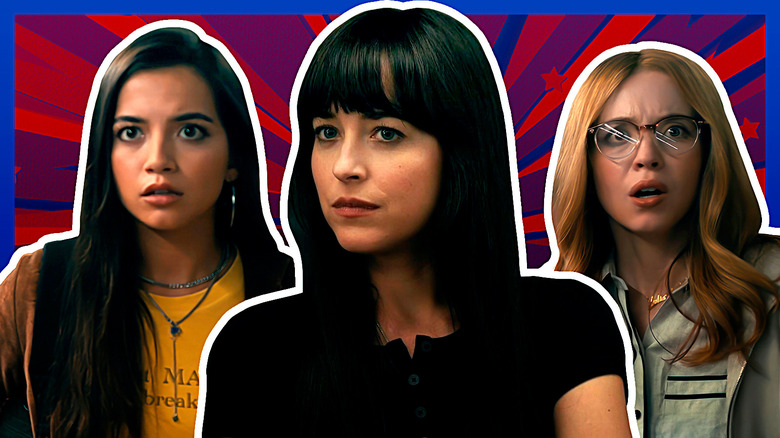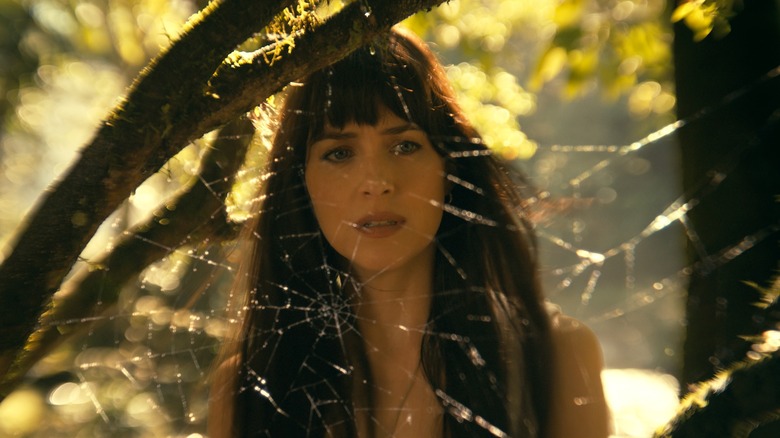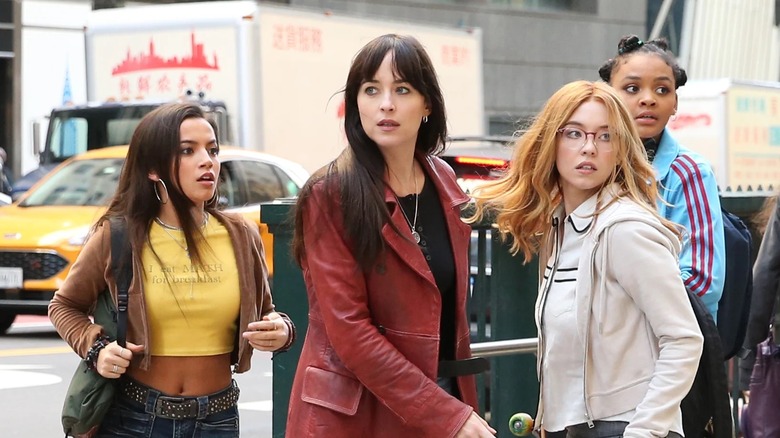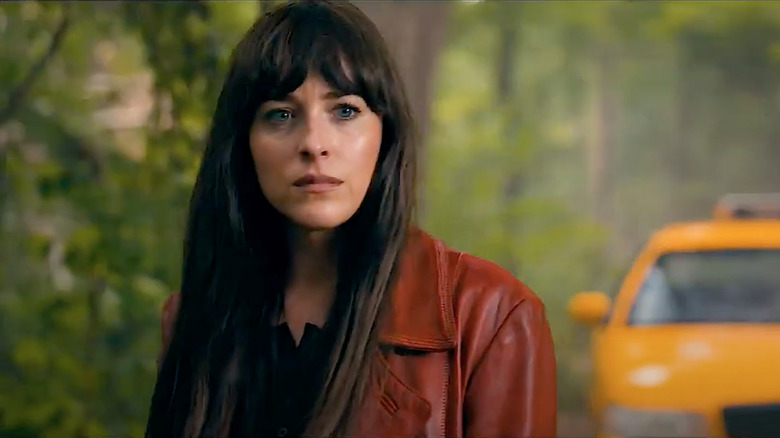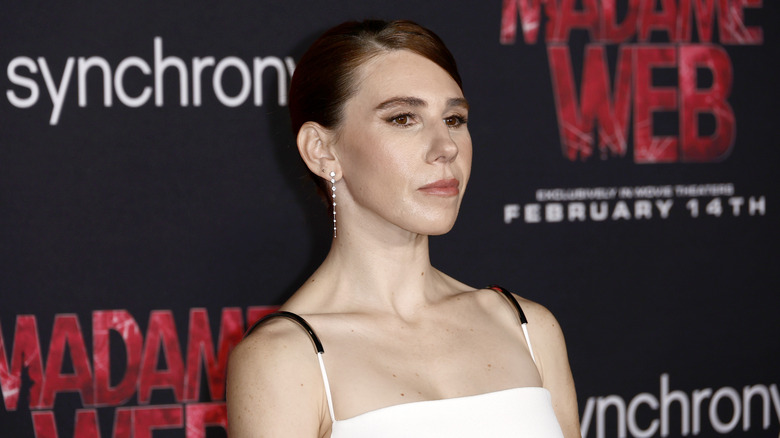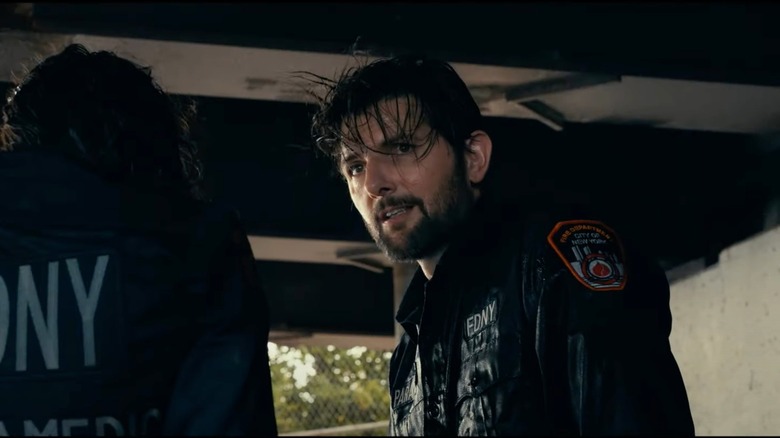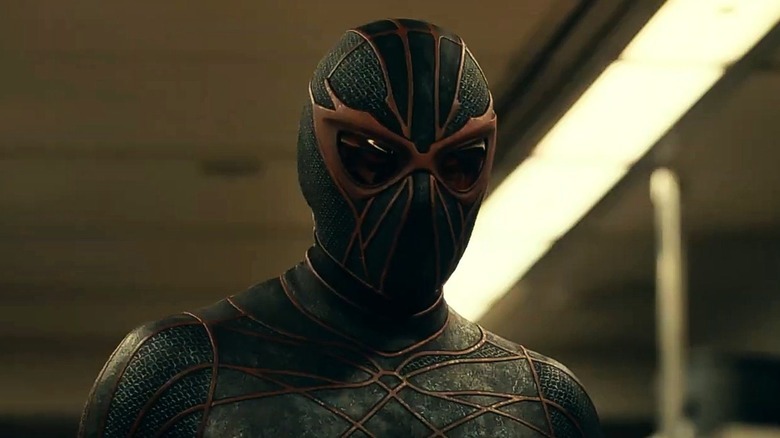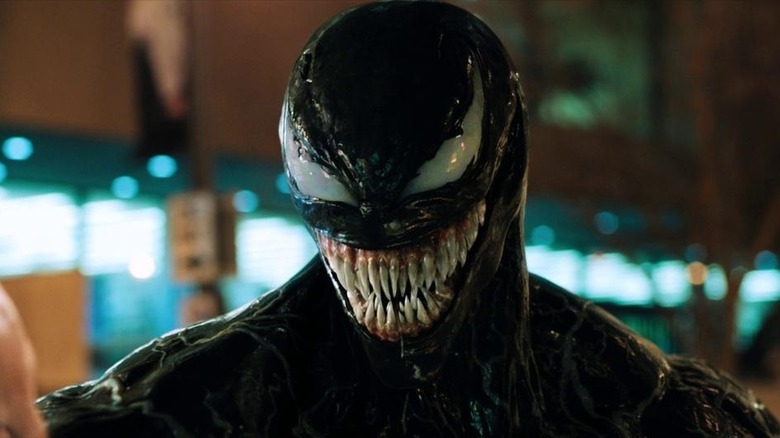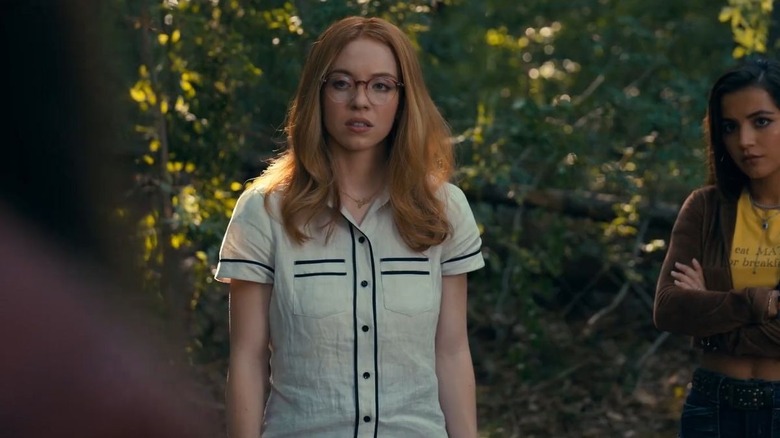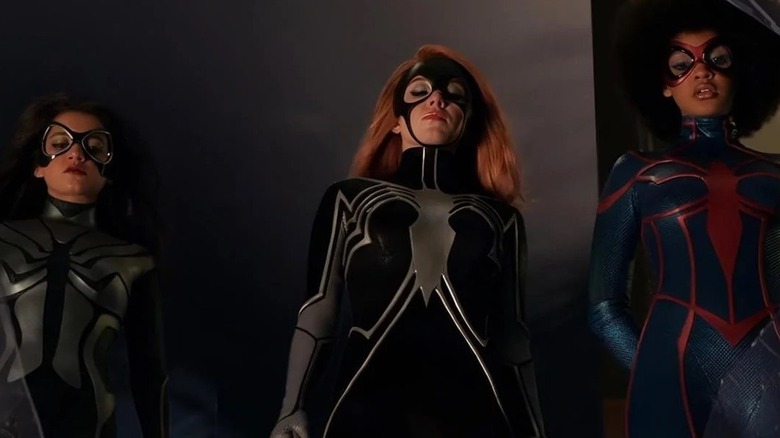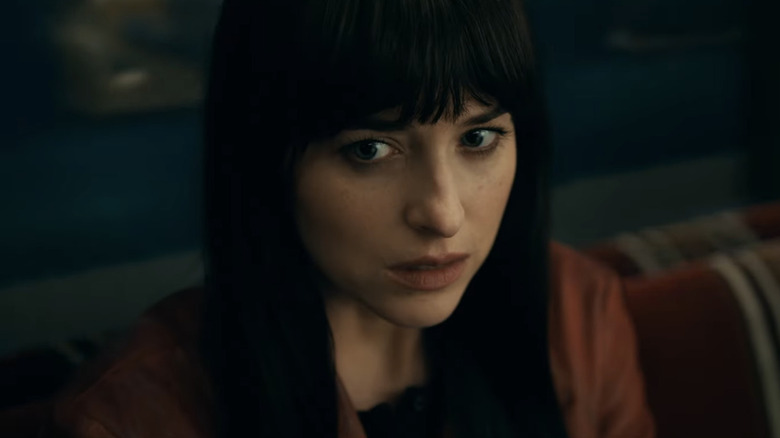Madame Web Ending Explained - What Is The Connection To The Spider-Verse?
Following the two "Venom" movies and "Morbius," Sony's Spider-Man Universe (SSU) expands to four entries with "Madame Web." This S.J. Clarkson-directed effort chronicles the origin story of paramedic Cassandra "Cassie" Webb (Dakota Johnson), who gains the ability to see the future following an accident. This puts her on the path to becoming the superbeing known in Marvel Comics lore as Madame Web. Before she achieves that status, though, Webb must protect a trio of young women, Julia (Sydney Sweeney), Mattie (Celeste O'Connor), and Anya (Isabela Merced), from the clutches of the spider-powered Ezekiel Sims (Tahar Rahim). These seemingly disparate souls will eventually become superheroes — but need to topple the powerful Sims if they want to have any kind of future at all.
In confronting this adversary, Webb will have to challenge her conception of the past and confront who she is now with her superpowers. That journey leads to an ending that, like those of so many superhero movies, is full of grand action beats and seismic character developments. In fact, viewers may be left needing some clarification on certain plot points, character fates, or comic book references scattered throughout the final minutes of "Madame Web," as well as some illumination on how the ending of "Madame Web" impacts future plans for Sony's Spider-Man Universe. Let's break down the ending of the movie and all the sticky scenarios that Webb and her friends gets trapped in.
What you need to remember about the plot of Madame Web
"Madame Web" firmly revolves around Cassandra "Cassie" Webb, an adult paramedic whose mom perished during childbirth while researching the healing powers of a rare spider in the Peruvian Amazon. Having spent her adolescence in the foster care system, Cassie isn't too good with people, as demonstrated by her inability to even properly respond to a grateful kid giving her a picture after she saves his mom. However, Cassie will need to quickly work on those personal shortcomings after a near-death drowning accident in which she gains clairvoyant superpowers, such as the ability to see the future. This puts Julia, Mattie, and Anya on Cassie's radar after she has a vision of them getting murdered by Sims.
From there, the plot of "Madame Web" concerns Cassie (who is framed for "kidnapping" the trio of teenagers) staying off the grid and trying to protect the youngsters while also coming to terms with her past. Developing a bond (through things like CPR rehearsals) with three people she's initially hesitant to connect with and learning details about her mom's life leads to Cassie realizing she can do so much more with her superpowers than she previously imagined. These character beats and plot threads all converge into the movie's finale, which sees Cassie, Julia, Mattie, and Anya trying to outrun Sims by sneaking into a warehouse full of explosive materials.
What happens at the end of Madame Web?
Having realized that Sims killed her mother 30 years earlier to gain possession of the rare Amazon spider and its powers, Cassie also learns that only venom from the same species saved her own life when she was born. As the leader of a tribe of "spider-people" explains when Cassie takes a quick third-act trip to Peru, the spider's bite also provided her with her own powers, which lay dormant until her near-death experience. From there, the finale of "Madame Web" plays out within the expectations of how a modern-day superhero movie climax operates, complete with Cassie remembering key events from her past to channel the maximum version of her superpowers.
After Cassie returns from Peru, she and her cohorts find salvation in a building full of explosives that they can use to fight back against Sims. Thanks to the four women using flares to kickstart these explosives, this volatile location eventually goes kaboom as Sims makes one last desperate bid to take Cassie and the teenage girls down. But after Sims is defeated by a team effort on their part and the warehouse goes down in flames, the film cuts to an epilogue in which Julia, Mattie, and Anya visit Cassie in her new apartment. This gives viewers a chance to see what Cassie looks like now, after she was blinded and paralyzed during the climactic fight — a development that's far more significant than it initially seems.
What the ending of Madame Web really means
The biggest detail about the ending of "Madame Web" that bears explaining is the importance of Cassie now being confined to a wheelchair and being blind. Dakota Johnson's version of Cassandra Webb now bears more of a resemblance to the comic book version of Madame Web, albeit with some drastic differences. Johnson is way younger than Web in the comics, for one thing, and the movie iteration of this character isn't tied to a life-support system. After a whole movie as more or less a normal person, the ending now brings Cassie closer to her uber-powerful comic book counterpart.
Cassie gets even closer to the comics version of Madame Web with a flash-forward vision into the future, in which she has donned a bright red spandex outfit (Julie, Mattie, and Anya are also wearing their respective superhero outfits from an earlier dream sequence in this closing scene). Confining Cassie's exaggerated attire to just these final shots is a bit of a peculiar move, given how obscure the comic book version of Madame Web is. It's doubtful that just seeing Dakota Johnson in a red outfit at the very end will register with most people. Still, while probably confounding to newcomers, that element of the "Madame Web" ending does tie into what Cassie could look like in future movies.
What happened to Sims' lady in the chair?
More than a few seemingly critical plot points in "Madame Web" never get resolved, including Julia's father issues, what's happened to the spider Sims kept in his apartment, and Cassie being a wanted fugitive. One character detail that also gets totally overlooked in the finale is the fate of Amaria (Zosia Mamet), a technology expert who functions as the right-hand woman of Sims ... aka his "woman in the chair." She helps Sims track down his three teenage targets throughout the film, even after initially expressing hesitation about hurting people so young.
If you exited "Madame Web" thinking you blinked and missed some kind of resolution to Amaria's presence in the movie, you didn't. At a certain point, Amaria just vanishes from "Madame Web," with the character never getting referenced once in the home stretch of the film. Sims doesn't even communicate with Amaria through an earpiece for technological assistance when he's trying to wipe out his targets. Amaria's initial hesitancy to help Sims would also lead one to believe there might be a "redemption" arc incoming for the character during the explosive ending, but nothing like that emerges. The "woman in the chair" of "Madame Web" truly does quietly disappear from the proceedings.
The actual identity of Mary Parker's baby
Cassandra Webb's best friend at her job is Ben Parker (Adam Scott), a guy who is very excited about his pregnant sister-in-law, Mary Parker (Emma Roberts), becoming a mother. The names of those characters will make the ears of even the most casual comic book geeks perk up while watching "Madame Web," given that Ben is Peter Parker's uncle and Mary is his mother in the comics (the future webslinger's father, Richard Parker, is mentioned by Mary as being "out of the country"). The playful teases about what this lady will ultimately name her baby are supposed to subtly hint at the idea that audiences are watching a stealth "Spider-Man" prequel.
Interestingly, though, the audience never gets to hear anyone refer to Mary's offspring as Peter even after he's born. The ending of "Madame Web" features Mary clutching her baby close (with Ben sitting next to her), though the two never call the child by his name. Recent reports have suggested that reshoots for "Madame Web" removed explicit connections to any of the recent "Spider-Man" movies. Dialing back on confirming that Mary's kid is Peter Parker may be part of Sony's plan to let "Madame Web" play out as a standalone enterprise rather than have its ending get overwhelmed in Spider-Man setup ... though such a plan does feel at odds with a movie where one of the lead characters is a young Uncle Ben.
Is Ezekiel Sims ever coming back?
First appearing in the world of Marvel Comics in 2001, Ezekiel Sims has become a recurring foe of Spider-Man and his associates throughout various comic storylines. Though he's not an especially famous or ubiquitous character in terms of his appearances in other forms of non-comics media, Sims is still a well-known enough comic book foe to make him seem like a reasonable candidate to transform into a recurring baddie across future SSU installments. The ending of "Madame Web" makes it clear, though, that Sims won't be back for further adventures in the "Madame Web" or "Venom" franchises, since he ends up falling to his death during the big finale.
In an ironic twist on being motivated to prevent his demise decades in the future, Sims meets his end in the year 2003 (by way of falling from a great height and then getting crushed by a crumbling letter from a neon Pepsi-Cola sign) while trying to eliminate his future killers. Granted, multiversal shenanigans could ensure that variations on Ezekiel Sims come back in the near future to torment other SSU characters. After all, there technically already was another version of Sims that made a cameo in "Spider-Man: Acrosss the Spider-Verse." For now, though, the ending of "Madame Web" makes it clear that this notable comic book foe is a one-and-done in the live-action realm.
Are there any references to other SSU movies?
So far, the SSU movies have been mostly standalone affairs with only minimal connections to one another — even if they've made a tenuous link to the Marvel Cinematic Universe. "Morbius," for instance, only featured a pair of offhand references to the "Venom" movies, although its mid-credits scene did feature "Spider-Man: Homecoming" baddie Vulture, played by Michael Keaton. Neither of the "Venom" movies teased the impending arrival of either Morbius or Kraven the Hunter, although "Venom: Let There Be Carnage" referenced the MCU Spider-Man played by Tom Holland.
"Madame Web" takes a cue from those titles in also being a standalone enterprise, though one innate quality of its story made that inevitable: "Madame Web" takes place in 2003, years before "Venom" and "Morbius" occur. There was no way (outside of time-travel shenanigans) that these characters could interact with one another.
The closest connection to other SSU titles is simply through background details, namely the recurring presence of The Daily Bugle newspapers and trucks, which have previously appeared in both "Venom" titles and "Morbius." Those Easter eggs are largely planted before the finale, which focuses squarely on the "Madame Web" characters. Even removing an explicit name-drop for Mary Parker's son allows the "Madame Web" ending to play things surprisingly standalone. So far, that seems to be par for the course for Sony's Spider-Man Universe, a shared continuity that, thus far, isn't very interested in mixing together comic book characters.
What has the cast and crew of Madame Web said about the ending?
Comic book movies are always kept under lock and key by studios to keep big plot turns or sequel teases under wraps. As such, the talent behind these features rarely delve too deeply into the endings of these blockbusters before they come out. That reality means, as of this writing, there's plenty of mystery surrounding how the key creative participants of "Madame Web" feel about the film's ending. However, some of the folks responsible for bringing the movie to life have still spoken about the greater significance of its conclusion.
Director S.J. Clarkson, for instance, told ComicBookMovie that the ending of the movie sets Webb and her cohorts up so that "they can go anywhere," especially due to how many comics the creative team could pull from.
Dakota Johnson, meanwhile, referenced the finale of "Madame Web" in an interview with Entertainment Weekly, where she remarked that working for the first time on a set heavy with blue screen sometimes drove her mad. The explosion-laden climax is meant to give audiences a jolt of excitement, but for Johnson, it was a bit more of an endurance test trying to execute the ending with occasionally nebulous visuals. Concrete thematic interpretations of the ending from Clarkson, Johnson, and others will come down the line, but right now, their statements about the ending of "Madame Web" reflect the effort they put into it.
What the end of Madame Web could mean for Sony's Spider-Man Universe
Even though "Madame Web" is meant to be a largely standalone exercise, you don't need clairvoyance to see how this title could impact future installments of Sony's Spider-Man Universe, particularly when it comes to the ending. While the movie takes place in 2003, the final scene sees Cassie witnessing a vision of the future where she, Julia, Mattie, and Anya are all costumed crimefighters taking on evildoers. It's not hard to imagine a time jump taking place that allows not only these teenagers to become fully-fledged superheroes, but also for these characters to rub shoulders with Sony's Spider-Man Universe characters like Venom and Kraven the Hunter that occupy the modern world.
Meanwhile, the implied birth of Peter Parker at the end of "Madame Web" gives the film an easy way to connect to potential "Spider-Man" entries (though connecting to the MCU Spidey specifically could be difficult, since "Venom: Let There Be Carnage" and "Morbius" both confirmed Tom Holland's wall-crawler exists in a different universe). It's also worth remembering that the comic book version of Madame Web eventually becomes a powerful enough psychic figure to have ripple effects across multiple universes. That power could, if translated to the world of movies, see Dakota Johnson's Cassandra Webb finding her way into the animated "Spider-Verse" titles. The "Madame Web" ending suggests that this movie is the tip of the iceberg for this character's powers.
What happens in the credits of Madame Web?
For nearly two decades now, audiences have been conditioned to stick around through the credits of movies drawn from the pantheon of Marvel Comics characters for an additional scene that may tease future sequels and adventures. While the Marvel Cinematic Universe popularized these credit scenes in movies like "Iron Man" and "The Avengers," they've existed in Marvel adaptations even before the MCU launched, as seen in projects like "X-Men: The Last Stand." Sony's Spider-Man Universe has kept this tradition alive with major mid-credit scenes in both "Venom" movies and "Morbius," teasing where these darker anti-heroes could go next in their respective exploits.
Naturally, then, moviegoers will sit patiently throughout the credits of "Madame Web" for some kind of tease of the future, perhaps a hint of a crossover with "Venom" or "Kraven the Hunter." However, it turns out that there's nothing to explain about the "Madame Web" credit scenes since they don't exist. There isn't any kind of scene nestled in the middle of the credits, nor even at the very end as a gag making fun of moviegoers who stick around for such sequences (like in DC's "Birds of Prey"). "Madame Web" just ends, making it a rare anomaly among modern Marvel Comics adaptations (alongside titles like "Dark Phoenix" and "Avengers: Endgame") to totally forego a credits scene.
